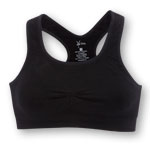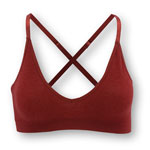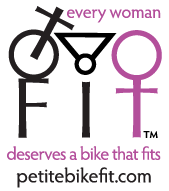If you’ve already read my review of wool bras, you’ll understand why I’ve fallen in love with the temperature regulation, moisture management and odor control qualities of wool. SmartWool socks actually HUG your feet with compression bands, flex zones, higher density yarn in the heel and metatarsal areas, ventilation zones and flat toe seam stitching for comfort. You’ll never buy another pair of socks that aren’t made of wool.  Smartwool offers a variety of weights for every climate, with an assortment of colors and heights. Available at REI and other online stores including http://www.smartwool.com. Cost varies, but averages at around $15.00/per pair.
Smartwool offers a variety of weights for every climate, with an assortment of colors and heights. Available at REI and other online stores including http://www.smartwool.com. Cost varies, but averages at around $15.00/per pair.
Author Archive | Brett
Wool Bras?
By Brett Aronowitz
08/02/2010One thing I don’t particularly like about cycling is wearing clothes made from synthetic fibers. They fit tight (and unless you have six pack abs, this is just not flattering), but have a sensational ability to wick and dry quickly. I continue to wear synthetic fabrics because I sweat profusely and live in a warm climate. This is especially important in Los Angeles where even in autumn, temperatures can climb to the triple digits.
 Athletic bras offer the same claims about their wicking ability. But, even after a short climb, when I reach the summit, my synthetic bra is drenched– and remains so—long after I’ve made my descent, leaving me saturated and chilled (even in the summer), for the duration of the ride.
Athletic bras offer the same claims about their wicking ability. But, even after a short climb, when I reach the summit, my synthetic bra is drenched– and remains so—long after I’ve made my descent, leaving me saturated and chilled (even in the summer), for the duration of the ride.
I look forward to peeling off my cold, sweaty, bra and putting on a soft cotton t-shirt. I love natural fibers and yet it would never occur to me to consider anything made of wool
Like many of you reading this, the wool we grew up with was too itchy for comfort. However, this renewable, sustainable and eco-friendly material has endured because of its unmatched qualities—it is temperature regulating and naturally antimicrobial.
And now, wool is making a comeback. It’s called Merino wool and, it’s machine washable and so soft and fine, it could almost be confused with cashmere. The wool fibers are small enough to be measured in microns.
According to Ibexwear.com,
a human hair is 60 microns wide compared to an old wool scarf made of wool fibers 30 microns wide. Ibex outdoor clothing is using Merino wool to make bras–that’s right –bras–using fibers only 17.5 microns wide.
I cannot describe what a genuine luxury it is to slip on one of their women’s balance sports bras. The seamless construction of this garment provides great comfort and ample support for low impact exercises like walking and cycling. Plus the mixture of wool, nylon and spandex is soft and does not bind or leave unsightly bulges. The sports bra comes in black, ivory, triathlon red and alligator green.
Even in the summertime, I can climb to the famous Griffith Park Observatory wearing one of Ibexwear’s jog bras and never feel cold, clammy or itchy. Sweat is wicked to the outer layer where it dries quickly. When I get home, I simply hang the bra up to dry and the next morning it’s as fresh as if it had just been washed. There is absolutely no residual odor, making this a perfect travel bra as well!
Ibex offers several different styles with a variety of support options including a more traditional light bra with straps that can be adjusted with a racerback option, and a support bra for medium-to-high impact sports like running. As a size note, I found that the light bra runs a little on the small side, but am anxious to try their support bra for running.
I’m so impressed with Merino wool by Ibex that now I’m wondering how bike shorts and jerseys made of wool would stack up to their synthetic competition.
Body Geometry Bikefit From Specialized
By Brett Aronowitz
08/02/2010All kinds of people are calling themselves bikefitters. Physical therapists and Chiropractors have even joined the ranks, and are now offering these services from their offices. How would one of their fits differ from one I can get from the guy (or gal) who works at my local bike shop?
In addition to my chiropractic education, I have been fortunate enough to attend both the Trek Fit Services Level One Class, as well as the Specialized Level one BG (Body Geometry) Fit class. Both companies have designed their classes around sound and widely accepted bikefitting practices. However, Specialized offers a more comprehensive, methodical approach compared to the competition. They’ve worked with Dr. Andy Pruitt from the Boulder Center for Sports Medicine to come up with a system that, after three intensive days of training and a suitcase of tools, will transform the average bike shop salesman or mechanic, into a qualified bikefitter. Their technique works from the feet up, and is included in their level one course.
In fact, this is where Specialized’s training excels. Once the basic contact points of the bicycle are adjusted to your body, the fit then focuses on your body’s interaction with the correctly adjusted bike—in some circles referred to as a 3-D fit.
The Specialized bikefitter is trained to observe how biomechanically sound you are on your bicycle. That is, are you sitting squarely on the saddle and are your knees tracking efficiently?
They learn which biomechanical adjustments will enhance your connection with the bike and create a more efficient machine that is less prone to injury.
Trained Specialized BG bikefitters don’t necessarily have the same detailed knowledge of anatomy or the refined observation skills of a medical professional, however they have learned to recognize and correct foot problems as they relate to cycling– which is something I didn’t learn during my four years of Chiropractic education. In cases where there maybe a more complex underlying medical condition, Specialized bikefitters are taught to refer their clients to a doctor or physical therapist.
I was thoroughly impressed with the level of teaching, the visual aids and resource materials provided to each student at SBCU (Specialized Bicycle Components University). I’m a seasoned student, and even for me, the hours were long (8am-7pm) and crammed full of information both in the classroom as well as the fit lab, where students spent a full twelve hours doing fittings on one another. Scott Holz’s experience and skill as an instructor and premier bike fitter of many Tour de France riders was impressive.
The bikes used for sizing and fitting during the SBCU class were their finest carbon models. For my sample fitting, I chose the Ruby in the smallest size manufactured, a 44 cm frame with 700c wheels. I chose the Ruby because it most closely matched my riding style and is designed to “make the long road feel short.”
Determining what made my legs so wobbly and inefficient during the pedal stroke was the most impressive portion of the fit, yielding the most significant results. With cleat adjustments, shims and new foot beds, the effect was to sure up my legs thereby adding stability, and efficiency, which directly translated to greater force on the pedals and improved performance. No other bike fitter has ever taken the time to address this integral relationship of me to my bicycle.
The overall training for this course was exceptional, and could be easily applied to fitting a petite woman—especially if she were on the correctly sized bicycle, and the fitter had a wider assortment of shorter stems at his or her disposal than were available in the BG fit lab. Unfortunately, neither Trek or Specialized even consider crank arm length in their fit assessment.
Which brings me to an important observation about one’s handlebar position…
Determining the correct distance to the handlebars is a much more subjective adjustment than those involving the lower extremities. My ongoing concern is the tendency of many bikefitters to approach the upper body portion of the fit to some ideal of what the rider’s potential core strength could be, instead of fitting them to their current level of conditioning. Specialized’s BG trainer Scott Holtz teaches, “always fit for the rider you have in front of you today—not the rider they think they may be in a year.” Most of us do not fall into the category of “natural athlete,” even though we all share a love of cycling. It’s crucial for us, as riders, to speak up when we’re too stretched out trying to reach the handlebars.
Both Specialized and Trek recognize the difference between sizing and fitting a bicycle, but in my opinion, no one does a better job of actually sizing a bike to its rider than the folks at R & E Cycles. Remember, they offer four different stock sizes of bicycles for women 5’2” and under, whereas most other manufacturers offer a total of only five sizes for their entire women’s line.
Bottom line: The more comfortable your bicycle is, the more you’ll ride. But, the more you ride, the more uncomfortable you’ll become because your body will likely get stronger and your style of cycling (favoring one position over another) may change. This is especially true if you have never been fit on a properly sized bike.
If you intend to ride no more than thirty miles a week, you may never notice your bike isn’t the perfect size—possibly because you’ve had such a great fitting. But, if like me, you spend hours at a time on your bicycle, then your bike should fit you like a glove. Will Specialized’s Women’s Bicycles fit you? It depends on your torso length, leg length, core strength and level of fitness as well as the distances you ride.
Remember. Over time, you will likely need another bike fitting to adjust to the newer, fitter cyclist you’ve become. Maybe then, you’ll decide to upgrade to another bicycle. Should you find a BG bike fitter even if you don’t have a Specialized bicycle? Absolutely, their training is superb.
Groovin’ While You’re Movin?
By Brett Aronowitz
08/01/2010“On your left,” I yell, trying to alert the cyclist in front of me that I want to pass her. She doesn’t budge. “On your left,” I scream, louder this time—but still, no reaction.
I’m riding a flat 20 miles around the local park – the same route I’ve been riding for years and it’s boring. The only way to extract any value from this ride is to try for a personal best on my new Rodriguez. “On your left” I scream again as I’m passing her. This time she jumps in her seat because I’ve startled her, and I notice she’s wearing ear buds. Until this moment, she hasn’t heard a thing.
Does she ride like this through traffic?
I’ve worn an ear bud two times while riding my bicycle. On both occasions, I nearly had accidents. Don’t get me wrong, there’s nothing I’d rather do than blast a medley of tunes by the Pointer Sisters into my body while I speed around the park, or up a tough hill—but I don’t dare. It’s too dangerous.
I must employ diplomacy while discussing this matter with my teenage son. Like many kids his age, he acts like he’s immortal and insists on listening to music when he rides. His defense: “I only use one ear bud.”
Enter the iHome2Go (also referred to as the iH85BX and the Bike to Beach Bicycle Speaker for iPod). If you’re a recreational cyclist who absolutely needs music to move, this item might just be the ticket. My goal was to provide my son with a safe alternative to his one ear bud.
The geniuses behind iHome2Go thought of just about everything. Here’s a list of what comes packaged with the product itself:
- An AC adapter that allows you to recharge your ipod while installed in the canister.
- Remote controller with handlebar mount
- Neoprene drawstring bag with shoulder strap for the beach
- Bicycle cage with clamp
- All necessary mounting hardware
The speaker canister looks like an oversized to-go cup and is made of a water and impact-resistant polycarbonate case. The speaker is situated on top of the canister, which sits snugly in the cage provided. It twists open at the center, allowing you to slide your ipod into the slot. (Please note: the iHome2Go works only with docking ipod models. It is not compatible with ipod shuffle and not recommended for ipod touch or iphone. (Click here for more details.)
It is imperative that you replace one of your water bottle holders with the enclosed cage, which has a special clamp, and will keep the iH85BX connected to your bicycle. Without it, one big bump will send the canister flying. Using the remote control that slides into the mount on your handlebars, you can manipulate the speaker volume or jump backwards and forwards effectively shuffling through songs that don’t have the right beat. The remote control easily slides out of the mount and back onto the top of the speaker for easy transport in its neoprene case.
The sound quality is surprisingly good and the volume output is loud enough to be heard on a fairly busy street.
The only thing missing are 4 AA batteries.
The trouble with the iHome2Go is the weight. No, I don’t mean the song by The Band, but rather the combined load of the speaker and cage. If you are one of those racers counting every single gram of weight on your bike, the iHome2Go is not for you. It’s heavy—plain and simple.
But a bigger issue, according to my son (who goes so fast he doesn’t care about the weight), is that when you pedal, the movement of each leg passing the speaker disrupts the sound flow and makes it seem like someone is playing with the balance. “It’s annoying,” my son told me as he was removing the unit from the seat tube of his bike. He did admit that by mounting the cage elsewhere, he might not have had this pesky problem –the only hitch was that the cage didn’t fit on the down tube. Remember, this is from a kid who doesn’t find it “annoying” to listen to music in one ear bud.
So there you have it. If you are a commuter, recreational cyclist, or riding a beach cruiser, using ear buds instead of listening for traffic and other cyclists, you might consider this product as a more safety-conscious alternative. It’s just not for racer-types or someone who needs to lose a few pounds.





